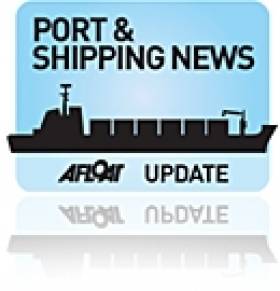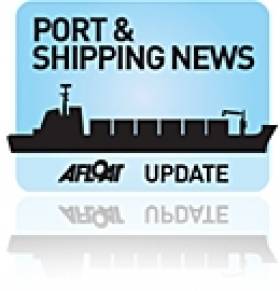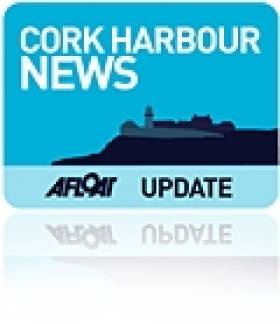Displaying items by tag: Irish Shipping Ltd
#IrishShipping - The liquidation of Irish Shipping Ltd three decades ago was the source of a row between two ministers of the then cabinet, as revealed in the recently published 1984 State papers.
The Irish Times has details of a 'secret' memo sent by then Minister for Communications Jim Mitchell addressed to the Government that questioned the judgement of then Finance Minister Alan Dukes in forcing the wind-up of the company.
According to Mitchell, there was "considerable merit in keeping ISL in operation until the end of 1985" despite requiring a further £20 million in State funds.
But another letter in the papers, this time from Dukes to Mitchell, argued that the memo represented "a direct questioning of my authority and competence".
ISL was eventually liquidated on 14 November 1984, a date marked by a reunion of former employees in Dublin last month.
The Irish Times has more on the story HERE.
Seafarers & Shore-Staff Recount Tales at Irish Shipping Ltd Reunion
#ISL30thReunion- Irish Shipping Ltd, the state-owned deep-sea shipping company that was liquidated 30 years ago was marked by former employees attending a reunion that was held on Friday in the Conrad Hotel, Dublin, writes Jehan Ashmore.
In recognition of the date's significance (14 November 1984) in Irish maritime affairs, the reunion attracted around 80 former seafarers and shore-staff. Despite the rather inclement weather they gathered at the city-centre venue to commemorate the event.
The origins of ISL stem from the outbreak of WW2 in 1939 which led to the Irish Government in 1941 to incorporate the state-shipping company. It was realised the stark reality of not having an Irish flagged fleet to meet the strategic importance of ensuring critical food and cargoes supplies to our dependent island. To distinguish Ireland's neutral position, the ships had the Irish flag and 'Eire' painted on the hulls.
According to Gerry McGovern, the reunion was attended by many Captains and stealing the show was Able Seaman, Desmond Brannigan who sailed in the Irish Poplar in 1941. A young photographer at the event asked Des, "Did the ship have the Irish colours painted on the side?" "It sure did" said Des, "we were bringing food to this country while fellows were trying to kill us, but we made it". Des is one of the last to brave the North Atlantic on an Irish flag ship during the war.
In 1942 the Irish Pine was sunk by U-Boat torpedo with the loss of all 33 crew members. A year later, Irish Oak was also a victim yet fortunately all crew were saved by fleet-mate Irish Plane and taken ashore to Cobh. Asides the stricken ISL ships, there were an additional 14 vessels from the Irish-registry lost during WW2.
Returning to the reunion, a mix of those who served a career at sea from throughout the various departments of deck, engine and catering chatted along with shore-staff office personnel. It was a night to remember, with lots of sea stories being told and some from a time long past!
Also in attendance were the four Wexford authors who produced the excellent book, 'Irish Shipping Ltd- A Fleet History'. The publication traces all the vessels of the grey-hulled fleet that reached the four corners of the world and proudly under the Irish flag!
ISL's fleet numbered 51 during the course of the company's 43 year existence. They were given a naming theme, where the prefix 'Irish' was followed by a name of a tree species. Examples, been the Irish Ash (painting by Kenneth King), Larch and Willow. There was the exception with two 'Star' vessels that were built for long-term charter.
As the company spanned several decades, most of these ship names were repeated and became well known in Irish shipping circles and in ports throughout foreign shores.
As previously referred, the Irish Willow (3) was a general cargoship of 1,743 tonnes built in Scotland and her sister Irish Fir was built at the former Liffey Dockyard Ltd. The current related business albeit in the form of ship-repair and maintenance firm Dublin Graving Docks Ltd is located nearby to the site of the old shipyard in Alexandra Basin.
The dry dock is currently occupied by an Arklow Shipping Ltd vessel, the dry-cargo bulker Arklow Willow (click report and for photo), whose name is aptly similar to ISL's vessel tree naming theme.
She is the only ASL ship to feature a 'tree' name from a 45-strong fleet that is in the majority under the Irish tricolour with the balance Dutch-flagged.
#IrishShipping@VCD – Irish Shipping Ltd had vessels built in the UK, outside Europe and notably during the tenure of Verolme Cork Dockyard which launched larger vessels before the 1984 closure of the company, writes Jehan Ashmore.
It should be also noted when ISL was formed in 1941, this included taking on the abandoned Cork dock 'yard' that was Rushbrooke Dockyard, where such facilities date to 1853. The yard allowed their ships to be repaired at the newly created Cork Dockyard Ltd.
The yard would change hands in 1959 as ISL invited Dutch shipping magnet Cornelius Verolme to purchase the dockyard and develop the Irish shipbuilding industry. Under the leadership of Verolme, 33 vessels were launched for various owners from the yard that at its peak employed 1,500 workers. For 25 years shipbuilding and offshore installations took place at the yard until its closure in 1984.
More than a decade later, the yard site was purchased in 1995 by the Burke Group. The 44-acre facility was reopened under the same name of Cork Dockyard Ltd running as a ship-repairer, engineering and fabrication business.
In the year before ISL's collapse, V.C.D. built the 'Panamax' bulk-carrier Irish Spruce. At almost 72,000dwt /40,000grt, she was easily the largest ever ISL ship built. In 1983 she was launched down the slipway at Rushbrooke onto the River Lee.
According to 'Irish Shipping Ltd- A Fleet History' (published in 2013) the chapter on the bulker gives the following principle dimensions: length 226m, breath 32.5m and a draught of 14.3m. She had 7 self-cleating McGregor holds. Her superstructure of bridge, accommodation and facilities was designed to a very high standard.
The order to have Irish Spruce built in Ireland was placed by a subsidiary of ISL, which itself was a state-owned company. The decision by the Irish Government at the time was controversial given the option of a far cheaper alternative from a Japanese yard. The decision proved costly, as the shipping company was already under financial burden.
Despite management and politics, Irish Spruce from a maritime perspective presented an impressive example of Irish shipbuilding skills, however she had the indignity of been laid-up under arrest in Marseilles when the company got into troubled waters.
The final ship from V.C.D. was the HPV L.E. Eithne (P31) ordered by the Department of Defence for the Naval Service and launched in 1984. The helicopter carrying HPV represented the last large ship completed in a major yard within the republic.
Last year during the national 'Gathering', events as previously reported commemorated Cork's shipbuilding heritage and workers. Centre-stage to this era of ship construction was the former shipyard of V.C.D.
'Irish Shipping Ltd- A Fleet History' Launched in Rosslare Harbour
#IrishShipping - A new publication 'Irish Shipping Ltd. – A Fleet History' as previously reported on Afloat.ie was launched recently with an official reception held in Rosslare Harbour.
More than 250 people attended the inaugural launch in the Hotel Rosslare which overlooks the ferryport. The publication was well received by the general public and critics alike and former ISL employee Capt. Jim O' Leary officially launched the long awaited publication.
It is anticipated that this book will be a great source of reference as well as telling the story of a very special shipping company. The promotional tour of the book continues with a launch taking place today in the Port of Cork Company's Boardroom at 6pm.
Also this week the National Maritime Museum of Ireland in Dun Laoghaire will be the venue on Thursday starting at 4pm. Appropriately another former ISL employee, Operations Manager Mr. Bill Lynch FICS, FCILT is to launch the book and again all are welcome to attend.
'Irish Shipping Ltd. – A Fleet History' involved around 5 years of research by the authors Brian Cleare, Leo Coy and brothers, Brian and John Boyce. They established the Rosslare Maritime Enthusiasts in 2004 and the group decided to proceed with the book venture following exhibitions on Irish Shipping Ltd in Rosslare Harbour and the National Maritime College of Ireland in Cork Harbour which attracted a combined attendance of over 2,500 people.
This is the RME's third publication, following the titles: 'Images of Rosslare Harbour' and 'The Ships of Rosslare Harbour'. They have received widespread respect in their field and much praise from renowned authorities in the maritime history sphere including the World Ships Society. Amongst the group are dedicated maritime historians, retired and serving seafarers, and local history experts.
In October 2012 the group established the Rosslare Maritime Heritage Centre which as reported is open to public on weekends.
Book Launch Tour: ‘Irish Shipping Ltd –A Fleet History’
#IrishShipping - The eagerly awaited publication 'Irish Shipping Ltd-A Fleet History' which traces every ship of the former state-owned shipping company, will be celebrated with an inaugural book launch this Friday in Rosslare Harbour, writes Jehan Ashmore.
The launch of the publication which covers the fleet from its humble beginnings in 1941 to its sad demise in 1984, is to be held in the Hotel Rosslare (22 Nov.) at 8pm.
All are welcome to the launch venue which appropriately overlooks the ferryport from where ISL's ferry division Irish Continental Line (ICL) ran routes to France. Among the ferries they run was the St. Killian which was notably lengthened in 1982.
Further book launches and signings are to take place next week, firstly in the Port of Cork Company's Boardroom on Tuesday (26 Nov.) at 6pm.
Two days later the book's promotional tour heads for another nautically apt venue, the National Maritime Museum of Ireland (NMMI) in Dun Laoghaire on Thursday (28 Nov.) at 4pm. The launch will be performed by the former Operations Manager in Irish Shipping, Mr. Bill Lynch FICS, FCILT, and again all are welcome to attend.
The authors, Brian Cleare, Leo Coy and brothers, Brian and John Boyce have spent the last five years researching and gathering material about the fleet that were mostly cargoships, bulk-carriers and a handful of oil tankers. All ships were named with the prefix 'Irish' followed by a species of tree, i.e. Irish Pine.
With over four hundred photographs, the publication is lavishly illustrated in covering every vessel of the fleet. Many of the photographs have never been published before.
This fine hardback (354pages) is priced €30.00 and will be an invaluable source of reference for many years to come. No doubt this new book will generate interest from former ISL seafarers, shore-staff and researchers. In addition to all those who hold dearly the importance of an Irish flagged merchant fleet and this unique period in our maritime history.
The authors as previously reported are also behind the Rosslare Harbour Maritime Heritage Centre and they will be holding additional launches nationwide, details made available upon confirmation. To keep track of book launches and of the centre visit the Rosslare Maritime Enthusiasts facebook page.
Screening to Mark ‘Mariners with Memories’
#MARITIME MUSEUM - A video recording of the 'Mariners with Memories" wreath-laying ceremony held at sea off Bray last year, is to take place tomorrow afternoon (at 14.30) in the maritime museum in Dun Laoghaire.
The ceremony which was held on 30 July involved a flotilla off Bray Harbour where floral tributes were made to commemorate all those lost at sea especially those whose last resting place is the sea which claimed their lives.
In addition the video presentation will also mark the 70th anniversary of the formation of Irish Shipping Ltd in 1941 and the founding of the Maritime Institute of Ireland (M.I.I.) which was also established in that year.
Copies of the D.V.D. will be available on request R.S.V.P. to this email: [email protected]
The institute aims are to foster an appreciation of the nation's maritime heritage and the museum which is located in the former Mariners Church. The museum has been closed for several years due to essential renovation, though is open on an invitation only basis during this winter. It is due to be officially re-opened in Easter of this year.
Activities of the M.I.I. (which is open to members) include running a winter/spring lecture programme, newsletters, a library, research and the hosting and supporting of commemorations.
For more information including how you can support them as a volunteer click HERE
Arthur's Day: Time to Reflect the Last Guinness Ships
The Lady Patricia represented the last of the more traditional Guinness vessels, though her predecessors The Lady Grania and The Lady Gwendolen differred in that they had split superstructures with the bridge admidships and accommodation quarters placed aft. Whereas The Lady Patricia had her superstructure positioned well aft.
In addition she was the last to carry a 'Lady' prefix name. She was named after the daughter of Lord Iveagh, Rupert Guinness, when entering service in 1962 from the yard of Charles Hill & Sons, Bristol. Her entry allowed the Guinness to be eventually replaced when she went to be scrapped at Faslane the following year.
Two deck-mounted granes that were used to hoist silver cylinders containing the beer where removed in 1973 from The Lady Patricia when she was converted into the world's first beer-tanker. The new method no longer required the cumbersome and time-consuming process of loading barrels from trucks. Instead trucks fitted with tanks transferred the liquid-cargo through pipes which involved pumped some 205,000 gallons or 1.87 million pints on board.
Unlike The Lady Patricia which was converted for tanker operations, the Miranda Guinness became the world's first custom-built beer-tanker when launched in 1976 from the Albion Shipyard also in Bristol. She also represented the last vessel to be launched (see PHOTO) there, after 156 years of shipbuilding.
Miranda Guinness was named by the Countess of Iveagh, after whom she was named. The newbuild replaced both The Lady Grania and The Lady Gwendolen which were sold. Since their launch The Lady Patricia and Miranda Guinness were registered in Liverpool until 1987 when the port of registry became Dublin. This arose following a change in the vessels management to Irish Marine Services Ltd, which was made up of former Irish Shipping Ltd management.
This arrangement only lasted to 1993 when Guinness discontinued the world's only beer-tanker shipping operation on the route linking Ireland and Britain. The process had allowed millions of pints to be served through the use of conveying the 'black-stuff' on board the dedicated beer-tankers or should that be those stout ships! Of the two vessels, the Miranda Guinness was the last to depart Dublin Port.
The ships were sold for scrapping on Merseyside and replaced in the form of 20-foot transportable tank trailers towed by trucks using Irish Sea ferry routes. Each of the silver tankers holds 10,000 gallons which is equivilant to 80,000 pints. It would take someone drinking 10 pints a day 22 years to drink it! Now that would be another challenge for the famous Guinness Book of Records!
In addition as we approach 17:59hrs, reflecting the 1759 date of the lease signing by Arthur Guinness, perhaps that minute could also be used to reflect a unique era in Irish brewing transportation methods and shipping history. By the way, Cheers to Arthur!
- River Liffey
- Ports and Shipping News
- Sir John Rogersons Quay
- Irish Shipping Ltd
- Guinness
- Guinness barges
- The Last Guinness Ships
- Arthur's Day
- The Lady Patricia
- Miranda Guinness
- Stout Ships
- Beer tankers
- Runcorn
- Manchester Ship Canal
- St. James Gate
- Stouttankers
- Charles Hiil & Sons Bristol
- Irish Marine Services Ltd
- Salford Docks
- Guinness concentrate
- Albion Shipyard Bristol
Passing of Irish Naval Service Officer Commander
Following his retirement in September 1980 he worked with Irish Shipping Ltd for a further five years during the construction of the state-owned company ships at the Verolme Cork Dockyard. At the same dockyard, he had also been closely involved in the design and commissioning of the Naval Service's helicopter patrol vessel L.É. Eithne, its largest vessel which was built in 1984.
To read more about the distinguished career of Cdr Liam Ahern and also his wartime role in the Royal Navy, his obituary is published in today's Irish Times.
Jehan Ashmore adds that the L.É. Eithne arrived into Dublin Port this morning to dock at Sir John Rogersons Quay next to the French Navy minehunter Cassiopée (M642) and mine-route survey craft Altaïr, which have been on a visit to the capital for the St. Patrick's festivities.
At 1,760 tonnes the L.É. Eithne is not only the largest vessel of Ireland's eight-strong fleet but is also the last ship of any type built in the Republic of Ireland. For a photo of the 27-year-old ship seen off Cobh (where Cdr Ahern was born) click here.
The 80m vessel has a crew of 85 (9 Officers and 77 ratings). Her main armament is a Bofors 57mm anti-aircraft gun with a LIOD fire control system and two 20mm Rheinmetals.
In 1986 L.É. Eithne made a historic visit as the first Irish Naval Service ship to cross the Atlantic, where she sailed to the United States, visiting Hamilton, New York and Boston. A decade later she became the first Irish Naval ship to tour the continent of South America.



































































